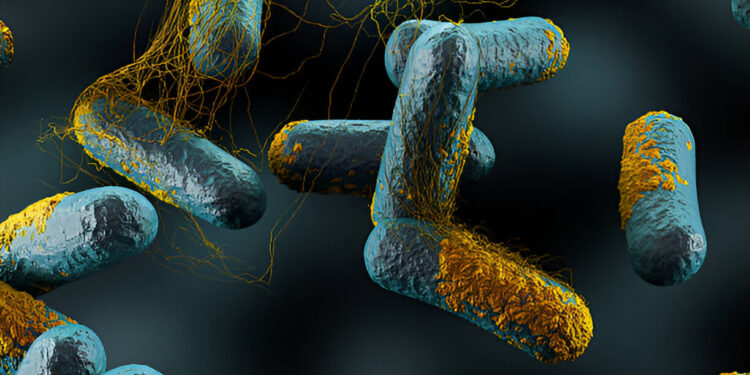Olusola-Makinde O. O. 1 Oriolowo D. K. 1
1Department of Microbiology, Federal University of Technology, Akure.
*Corresponding Author Email:ooolusola-makinde@futa.edu.ng
Abstract
The study investigated the quantitative microbial risk assessment of Clostridium perfringens in beef samples obtained from retail markets in Akure metropolis, Ondo State. One hundred and forty beef samples were obtained aseptically at intervals (morning and afternoon) between February and March 2024. Serially diluted beef samples were pour-plated and inoculated on Reinforced Clostridial Agar. Colonial, morphological and biochemical characterisation of isolates was determined using conventional methods. Antibiotics susceptibility profiling of isolates was carried out using disc-diffusion method. Molecular identification of bacterial isolates was carried out using 16S rRNA gene sequence analysis. The quantitative microbial risk assessment of isolates was carried out using an approximate Beta-Poisson dose-response model to estimate the probability of infection (pi) with the pathogens. A higher sensitivity to sparfloxacin was recorded with 30.10±0.12mm, 29.23±0.12 mm, 27.77±0.26 mm, 25.13±0.34 mm, 22.33±0.20 mm, 25.33±0.28 mm, 22.10±0.17 mm, 20.37±0.30 mm respectively. A 75% resistance to augmentin and 25% resistance to amoxicillin was recorded. C. pefringens probability of infection (pi) per meal per week was high (38.4%). The risk of death (0.00%), yearly risk of illness (0.999) and death per meal (0.053) were obtained, which indicates that the microbial risk from C. perfringens during accidental and/or intentional consumption of beef is low.
Keywords: Antibiotic Resistance, Beef, Clostridium perfringens, Microbial Risk Assessment, 16S rRNA.
1. Introduction
Pathogens that enter the body through food can cause illnesses referred to as foodborne diseases (Todd, 2020). According to Pandhi et al. (2023), disease agents can be either naturally occurring in food or added to it from the outside. They can be toxic or infectious, typically produced by bacteria or fungi. Food poisoning caused by bacteria is most often caused by Staphylococcus sp., Salmonella sp., Clostridium perfringens, Escherichia coli, Bacillus cereus, and, less commonly, C. botulinum. Except for botulism, which is primarily marked by neurological symptoms, the usual symptoms include fever, weakness, and gastroenteritis. Raw beef-related foodborne infections continue to pose the greatest threats to worldwide food safety (Todd, 2020).
Food poisoning outbreaks, especially cooked pork products, have been associated with anaerobic bacteria termed C. perfringens, whose spores can withstand heating to 100 °C (Uzal et al., 2010).
These bacteria will likely infect beef products after slaughter through contaminated surfaces or carcasses exposed to faeces (Leung et al., 2016). Furthermore, spores of Clostridial species that might infect raw beef can be found in dirt, knives, hands, cutting boards, worker clothing, including water used to wash the body, animal waste, and unhygienic transportation methods to butcher shops (Hillers, 2003).
One million of the 3.9 million foodborne illness outbreaks in the US that are attributed to bacteria each year are thought to be caused by C. perfringens (Scallan et al., 2011). Nigeria requires that C. perfringens type A outbreaks be reported, while Turkey, like many other nations, does not. Because of this, estimating the anticipated public health consequences of these epidemics is challenging.
Due to its heat resilience, C. perfringens may develop spores that can flourish at temperatures between 15 and 55 °C (Mohiuddin et al., 2020). Dominant exotoxins are the main source of gastrointestinal illnesses caused by C. perfringens in humans and animals. Major toxins, minor toxins, and enterotoxins are the three categories into which C. perfringens toxins fall. While enterotoxins are toxins that invariably harm epithelium, the main toxins are alpha, beta, epsilon, and iota. Every other poison is a minor poison (Gangwar, 2022). Based on the synthesis of certain exotoxins, such as alpha (α), beta (β), and epsilon, C. perfringens may be categorised into five categories (A to E) (Bendary et al., 2022). A plasmid-mediated cpa gene encodes the α-toxin, associated with serotype A and all other serotypes of C. perfringens (Garvey, 2023). At the same time, cpb and etx plasmid-mediated genes that produce β- and ε-toxins, respectively, are present in serotype B. Serotype E carries the plasmid-mediated iap gene, which generates ι-toxin (Adams et al., 2015), whereas serotypes C and D are linked to β- and ε-toxins, respectively (deCastro et al., 2021). The cpe and cpb2 genes, which generate C. perfringens enterotoxin (CPE) and C. perfringens beta2 toxin, are probably present in all serotypes (Bendary et al., 2022).
Numerous antibiotics, such as ampicillin, tetracycline, imipenem, metronidazole, and chloramphenicol, have been utilised as preventative measures in the cattle business in a number of countries to lessen the financial losses caused by these illnesses (Barua et al., 2021). Over the past ten years, there has been little research on the antimicrobial resistance of C. perfringens from various sources, including the most common source of infection in meat samples, despite growing public awareness of the need to combat antimicrobial resistance to improve public health (Yadav et al., 2022).
2. Materials and Methods
2.1 Isolation of Clostridium perfringes
A hundred and twenty eight raw beef samples at intervals (morning and afternoon) were collected from shops at Oshodi market, Isinkan market, FUTA market, and Ijomu market of Akure city between February and March 2024 and transported to the Microbiology laboratory, Federal University of Technology, Akure for further analysis within 2hrs of collection. The raw beef and swab samples were taken in small sterile polyethylene bags to avoid bacterial contamination and placed in a buffer solution (PBS) with a double volume of phosphate and sterile universal bottles. The collected samples were prepared according to the procedure recommended by the International Commission on Microbiological Specifications for Foods to achieve small-fold serial dilution-five grams or ml of each meat were suspended into 225 mL of sterile peptone water (Oxoid, Basingstoke, UK). The sample homogenates underwent heat shocking at 80 °C in a water bath for 15 min to kill the non-spore-forming aerobic bacteria. A total of 1 mL from each of the previously prepared dilutions was streaked onto Reinforced Clostridial agar (RCA) agar (Oxoid, Basingstoke, UK) plates, and all plates were incubated at 37 °C for 24 h in an anaerobic jar HP-11 (Oxoid, Basingstoke, UK), with gas generating kits (Oxid, Basingstonon-spore-forminges were observed for the growth of C. perfringens, which was evident by the presence of characteristic white colonies. The plates showing white colonies were selected and counted. The results were interpreted as colony-forming units (CFU) per gram or mL of the sample. The presumed colonies on the agar plates were further purified by sub-culturing under the previously described conditions and stored on double-strength nutrient agar slants at 4°C for confirmatory tests (Ansari et al., 2022).
2.2 Biochemical characterisation of selected isolates
To determine the presumptive isolates for C. perfringens, biochemical characterisation of isolates was carried out. The tests included Gram staining, endospore staining, catalase test, oxidase test, citrate test, gelatin hydrolysis, hemolysis, MR-VP, indole test, triple sugar test, urea test, and sugar fermentation.
2.3 Molecular Characterisation of presumptive C. perfringens isolates
Polymerase Chain Reaction technique was used to confirm presumptive Clostridium perfringens isolates and identify its toxin genes (cpa, cpb, cpe, etx) of C. perfringens isolates. Table 1 lists the primers used in this investigation to identify the toxin genes of the isolates of C. perfringens.
Table 1: Primers for Virulence gene amplification

2.4 Antibiotic sensitivity of C. perfringens isolates
A panel of ten antibiotics inclusive of septrin (30 µg), chloramphenicol (30 µg), sparfloxacin (10 µg), ciprofloxacin (30 µg), amoxicillin (30 µg), augmentin (10 µg), gentamicin (30 µg), pefloxacin (30 µg), ofloxacin (10 µg), and streptomycin (30 µg) were used to determine the sensitivity of the bacterial isolates from raw beef samples.
2.5 Quantitative Microbial Risk Assessment
Data from the laboratory were used to enumerate the occurrence of Clostridium perfringens, while antibiotic susceptibility and points estimating Beta-Poisson Dose response were used for risk assessments. The assumptions used in risk assessment are presented in Table 2. The probability of death/illness was obtained from Chowdhury et al. (2022) and the shape parameter (K) from Amatobi and Agunwamba (2022).
Table 2: Beta-Poisson assumptions obtained from literature used for the quantitative microbial risk assessment

3. Results
3.1 Bacterial count derived from meat sample
The mean total count in the meat collected during the morning and afternoon periods was found to be of higher microbial counts.
3.2 Morphological and biochemical characteristics of Clostridium perfringens
A total of thirty six (36) isolates representative bacterial isolates were selected for characterisation and further identification. The colonial morphology of the selected isolates was flat, and colony colour ranged from cream and white to blue. The surface texture of isolates was dry, while some were shiny. Edges of the colonies were either entire, irregular or undulate. Optically, all isolates were either opaque, transparent or translucent and with respect to size and shape, isolates were either small, medium or large and irregular, circular or spindle.
In this study, C. perfringens were identified using different biochemical tests such as catalase, oxidase, triple sugar iron, Simmons citrate, haemolysis, motility, indole, methyl red, gas production, H2S production, acid production, gelatin hydrolysis, endospore, urease and gram reaction test (Table 3). As indicated in Table 3, the results of the biochemical characterisation showed that the isolates were Gram-positive and non-motile rods. Most of the isolates were catalase positive. There were significant differences in the biochemical test results, with some positive and others negative.

Figure 1a: Total mean Clostridial counts (cfu/g) of raw beef samples from Ijomu market sample

Figure 1b: Total mean Clostridial counts (cfu/g) of raw beef from Isinkan market sample

Figure 1c: Total mean Clostridial counts (cfu/g) of raw beef from Oshodi market sample

Figure 1d: Total mean Clostridial counts (cfu/g) of raw beef from FUTA market sample
Table 3: Biochemical characterisation of isolates

KEY: + =Positive – = Negative, MR = Methyl red VP = Vogues Proskauer H2S = Hydrogen sulfide
3.3 Antibiotic sensitivity pattern of selected isolates
Ten antibiotics septrin (30 µg), chloramphenicol (30µg), sparfloxacin (10 µg), ciprofloxacin (30 µg), amoxicillin (30 µg) augmentin (10 µg), gentamicin (30 µg), pefloxacin (30 µg), ofloxacin (10 µg), and streptomycin (30 µg)] were used for antibiotic sensitivity.A higher sensitivity to sparfloxacin was recorded with 30.10±0.12mm, 29.23±0.12 mm, 27.77±0.26 mm, 25.13±0.34 mm, 22.33±0.20 mm, 25.33±0.28 mm, 22.10±0.17 mm, 20.37±0.30 mm respectively. A 75% resistance to augmentin and 25% resistance to amoxicillin was recorded, as shown in Table 4 and Figure 2.
3.4 Molecular characterisation of Clostridium perfringes isolate
With bioinformatics studies, the DNA sequence of the amplified DNA genome shown in Plate 1 shows the positive amplification of the 16S regions amplified from the selected bacteria samples on agarose gel and proves the presence of only cpa and cpe toxin virulence enterotoxin genes of C. perfringens that were isolated from meat products by using agarose gel electrophoresis of multiplex PCR.
3.5 Quantitative microbiology risk assessment
Table 5 shows the results of the probability of infection from C. pefringens per week (of various isolated organisms) from eating one kilogram of meat. Table 5 shows the probability of yearly risk of infection from C. perfringens, and Table 6 shows the results for the probability of yearly risk of illness, yearly risk of death and risk of death per meal from C. perfringens.
Table 4: Antibiotic sensitivity profile of selected isolates


Plate 1: Agarose gel electrophoresis of polymerase chain reaction products of Clostridium perfringens isolates

Plate 2: Agarose Gel picture of virulence gene amplified from Clostridium perfringens isolates. Lane 1: DNA ladder with 50 base pairs Lane 2: Positive control of C. perfringens type B Lane 6: C. perfringens type A enterotoxin. Lanes 3, 4, 5, and 7–12, C. perfringens type A, 658 bp represent Base pairs, 324 bp represent Alpha gene, 233 bp represent CPE gene
Table 5a: Probability of infection from C. perfringens per meal per week

Table 5b: Probability of yearly risk of infection from C. perfringens

Table 5c: Probability of yearly risk of illness, yearly risk of death and risk of death per meal

4. Discussion
Food, typically meat, can be spoiled by Clostridium species which results in gas and foul odour (Kyrylenko et al., 2023). The poor sanitary habits of meat handlers may be as a result of low level of education. Gashe et al. (2020) is in alignment with the study where he reported that the meat handlers’ limited understanding of food handling and processing procedures is due to their low level of education Food handlers can be trained in fundamental principles and personal hygiene to ensure food safety (Bersia et al., 2020). Just 18% (2) of the food workers in this sample developed skin problems.
Similarly, WHO rules prohibited food handlers with jaundice, diarrhoea, vomiting, fever, sore throat with fever, discharge from the ear, eye, or nose, or skin lesions that were clearly infected from handling food (WHO, 2021). According to data on meat handlers’ personal hygiene, 78% covered their hair when serving customers, and 44% wore clean working jackets. Therefore, the observed findings are consistent with the WHO guideline that requires food handlers to wear appropriate and clean attire (WHO, 2021). According to Balcha and Gebretinsae (2020), over 58% and 42% of the food handlers employed by Mekelle’s butcher shops, respectively, wore dungarees and hair covers.
The retail establishments in the current investigation had subpar general cleanliness conditions. Similarly, Zerabruk et al. (2020) noted that the meat items were not kept apart and that most of the retail establishments included in the study had unsanitary conditions. According to Ali et al. (2010), most retail establishments examined had inadequate cleaning practices and a lack of disinfection expertise.
High levels of cross-contamination and recontamination of meat were caused by improper handling and sanitary procedures. In the retail stores, most of the meat goods were kept on tables for more than eleven hours. This procedure can provide harmful or spoiling bacteria enough time to flourish.
According to Ali et al. (2010), maintaining sanitary surroundings in retail establishments requires more than washing them once every 24 hours using detergent and water. In line with this study, Muleta and Ashenafi (2021) found that microorganisms drastically double in size if food is kept at temperatures between 15 and 45 °C for longer than four hours. According to this report, cashiers are present in 20% of retail establishments to collect payments. As a result, it lessens the chance that meat would get contaminated by rotting microbes, which might pose a serious health risk. In contrast, 92% of food handlers in Mekelle retail stores handled cash and food service simultaneously, according to Balcha and Gebretinsae (2020).
The mean values of the total anaerobic count of the meat samples under examination were 6.0×105, 2.4×108, 3.3×106, 8.0×105, 4.6×108, 7.6×108, 3.6×108 log cfu/g respectively. This is in disagreement with studies of Zakaria (2009) that did not detect anaerobic spore-forming microorganisms in the examined meat samples whereas Ahmed et al. (2022), who isolated anaerobes from meat samples with mean value of 1.5×107 ± 3.5×106 log cfu/m2
The study revealed a high percentage (57%) of C. perfringens contamination in sampled beef. The high contamination of food with C. perfringens has been related to inappropriate personal hygiene of the food handlers during the handling and processing of meat products (Alves et al., 2021). It indicates the health hazards of consuming raw meat handled under unsanitary circumstances.
C. perfringens is a common digestive tract habitant that might infect the corpse during an unsanitary slaughter procedure. According to El-Bayomi et al. (2020), the prevalence of C. perfringens in the current study is greater than 11.2% in India and 5.6% in Turkey. However, a Moroccan investigation on banger found no evidence of C. perfringens (Saad et al., 2022). While Yadav et al. (2022) found that C. perfringens was isolated from 40%, 28%, and 20% of sausage, beef burger and luncheon samples in Kalyobia Governorate, Egypt, Francher et al. (2021) reported a higher incidence of C. perfringens (30%) in western Massachusetts. A 71% of the retail raw meat samples that were analysedanalysedanalysed in Japan had C. perfringens (Miki et al., 2008). According to Atwa and Abou EI-Roos (2011), C. perfringens was isolated from meat items that were ready to cook and consume in the Menoufiea and Gharbia Governorates of Egypt, with percentages of 48.8% and 21.3%, respectively. Variations in unhygienic environments, inadequate personal hygiene, and cross-contamination between raw and cooked meat products may be the causes of the variations in C. perfringens prevalence (Silva et al., 2022).
Clostridial species produce more toxins than any other type of bacterium. Among the Clostridium species, C. perfringens is the most prevalent and prolific creator of toxins; it is present in soil, the microbiota of animals, and human bodies. Two of the virulence components of C. perfringens, enterotoxin and beta toxin, have received greater attention than others because of their role in the aetiology of C. perfringens-associated disease (CPAD) in both people and animals (Fourie et al., 2020).
Based on the development of certain exotoxins [alpha (α), beta (β), epsilon (ε), and ι (iota)], C. perfringens can be serotyped into five groups (A to E). (Moustafa et al., 2022). Serotype A and all other serotypes of C. perfringens are linked to the α-toxin, which is encoded by a plasmid-mediated cpa gene (Wang et al., 2020). The cpb and etx plasmid-mediated genes that encode β and ε-toxins, respectively, are present in serotype B. Serotype E possesses the plasmid-mediated iap gene, which generates ι-toxin, whereas serotypes C and D are linked to the β- and ε-toxins, respectively (de Castro Oliveira et al., 2021). All of the C. perfringens isolates that were analysed tested positive for alpha-toxin. However, not all of them tested positive for C. perfringens enterotoxin (cpe). Shelke et al. (2020) published similar results, indicating that all strains of C. perfringens did not create enterotoxins.
Furthermore, Lin and Labbe (2003) found that while all C. perfringens isolates had the alpha toxin gene, none of them had the cpe gene.
According to Heikinheimo and Korkeala (2005), isolates of C. perfringens that tested negative for enterotoxin-encoding genes had alpha-encoding genes. According to Gurmu et al. (2013), 15.15% of C. perfringens isolates in India were positive for cpe. According to Yibar et al. (2018), the cpe gene was present in 27.2% of C. perfringens isolates from raw, cooked, and consumable meat and meat-based products in Turkey. The manufacturing process and the degree of contamination during processing, packing, and storage may be to blame for the discrepancies in the results (Kamboj et al., 2020).
All C. perfringens isolates from this study were assayed against ten different antibacterial drugs used in therapeutic treatment to determine their in vitro antibiotic susceptibility patterns. Each isolate had a unique pattern of drug sensitivity and resistance. The most isolates were most susceptible to sparfloxacin (30ug) with 30.10 ±0.12 mm, 29.23 ±0,12 mm, 27.77 ±0.26 mm, 25.13 ±0.34 mm, 22.33 ±0.20 mm, 25.33 ±0.28 mm, 22.10 ±0.17 mm, 20.37 ±0.30 mm respectively. A 75% resistance to augmentin (10ug) and 25% resistance to amoxicillin (30ug) was recorded. Indian researcher Khurana et al. (2022) observed sensitivity to ciprofloxacin (93.3%) and chloramphenicol (76.60%) during an in-vitro sensitivity test of 30 bacterial isolates to 11 antimicrobial drugs; this is in alignment with the present study. Another research conducted in Tamil Nadu’s Coimbatore In contrast to the current investigation, Skariyachan et al. (2010) demonstrated that C. perfringens isolates had much greater sensitivity to gentamicin (96.73%), tetracycline (93.47%), and vancomycin (92.39%). On the other hand, C. perfringens isolated from mammals and birds is more susceptible to ciprofloxacin and norfloxacin, according to Rahman et al. (2012).
Mehtaz et al. (2013) found that poultry and meat from clinically sick but healthy animals were sensitive to ciprofloxacin (88.78%), ofloxacin (82.65%), and norfloxacin (80.61%). Norfloxacin (67%) and ciprofloxacin (58%) were among the other antibiotics that showed notable resistance (Osman et al., 2013). Many nations, including Switzerland, Denmark, Norway, Belgium, and Brazil, continue to treat animal infections caused by C. perfringens with tetracyclines and other antimicrobials. In Belgium, the United States, Scandinavia, and India, beef, chicken, and swine meat were found to contain β-lactam antibiotics, which have been shown in several studies to have a strong inhibitory effect on C. perfringens. A major public health worry at the moment is the prevalence of multi-drug resistance in C. perfringens, which is widespread and/or developing (Bendary et al., 2022). A recent study indicated that the majority of multidrug-resistant bacteria in retail meats originate from farms or veterinary clinics where animals get antibiotics for treatment or as feed (Samy et al., 2022). Two of the eight isolates from different meat samples in the current study were multi-drug resistant. Because genes producing antimicrobial resistance may be transferred between bacteria, which can be observed during the food production process, antimicrobial stewardship at the farm stage is crucial.
The quantitative microbiological risk assessment (QMRA) approach aims to quantify and characterise the spread of harmful bacteria from food and animals to people. For Clostridium perfringens, QMRAs were investigated. The aim was to find the most important pathogen characteristics (such as growth and pathogenicity) and associated metrics that may be utilised to enhance QMRA.
In order to determine the extent of each parameter’s influence on model results, a thorough list of the attributes and parameters utilised across the food chain was created, and the sensitivity of each parameter in each QMRA was assessed.
The probability of infection (pi) per meal per week for C. perfringens was high (38.4%). The risk of death (0.00%), yearly risk of illness (0.999), and death per meal (0.053) were obtained, which suggests that the microbial risk from C. perfringens during accidental and/or intentional consumption of beef is low. This knowledge is essential for identifying the key aspects that warrant attention in future research. The virulence of C. perfringens, which impacts the dose–response phase of the QMRA model, was identified as promising candidate for associating different symptoms observed in humans.
5. Conclusion
The study confirmed the presence of Clostridium perfringens in beef samples vended at retail markets in the Akure metropolis, Ondo State. The major factors that contributed to meat contamination were low-level awareness of hygienic practices, improper handling of money, and poor sanitation of the retailer’s shops. The work revealed a 20% prevalence of C. perfringens, and the antibiotic study recorded resistance to amoxicillin and augmentin. The presence of C. perfringens alpha toxin and cpe gene was revealed in the studied beef samples. These findings indicate that beef contaminated with C. perfringens enterotoxin gene is an important risk factor for food intoxication, and food handlers that produce and process meat and meat products must have suitable food safety procedures.
The qualitative microbial risk assessment of C. perfringens confirmed in the study shows the risk of death (0.00%), the yearly risk of illness (0.999), and death per meal (0.053) obtained, which indicates that the microbial risk from C. perfringens during accidental and/or intentional consumption of beef is low. This also indicates that beef consumption may pose public health hazards; hence, hygienic procedures and practices from slaughter to consumption must be strictly adhered to.
Acknowledgement
The authors would like to acknowledge the Department of Microbiology, Federal University of Technology, Akure, for facilitating laboratory space and providing other facilities.
Funding
This study was funded independently by the authors in this study. The research did not receive any specific grant from funding agencies in the public, commercial, or not-for-profit sectors.
Consent to participate and publish
The authors agreed to publish this research article.
Conflict of Interest
The authors declare that they have no known competing financial interests or personal relationships that could have appeared to influence the work reported in this paper.
References
Ahmed, H. A., El Bayomi, R. M., Hamed, R. I., Mohsen, R. A., El-Gohary, F. A., Hefny, A. A., & Tolba, H. M. (2022). Genetic relatedness, antibiotic resistance, and effect of silver nanoparticle on biofilm formation by Clostridium perfringens isolated from chickens, pigeons, camels, and human consumers. Veterinary Sciences, 9(3), 109-115
Ali, N., Farooqui, A., Khan, A., and Kazmi, S. (2010). Microbial contamination of raw meat and its environment in retail shops in Karachi, Pakistan,” Journal of Infection in Developing, 9(3), 109-125
Alves, A., Viveiros, C., Lopes, J., Nogueira, A., Pires, B., Afonso, A. F., and Teixeira, C. (2021). Microbiological contamination in different food service units associated with food handling. Applied Sciences, 11(16), 7241-7253.
Atwa, E.I. & Abou EI-Roos, N.A. (2011). Incidence of Clostridium perfringens in meat products at some Egyptian governorates. International Journal of Microbiological Research, 2: 196–203.
Balcha, C., and Gebretinsae, H. (2020). Assessment of bacteriological quality of meat contact surfaces in selected butcher shops of Mekelle city, Ethiopia,” Journal of Environmental Occupational Science, 2 (2), 61–66.
Barua, P., Rahman, S. H., and Barua, M. (2021). Sustainable value chain approach for livestock-based livelihood strategies for communities of the southeastern coast of Bangladesh. Modern Supply Chain Research and Applications, 3(3), 191-225.
Bendary, M. M., Abd El-Hamid, M. I., El-Tarabili, R. M., Hefny, A. A., Algendy, R. M., Elzohairy, N. A., & Moustafa, W. H. (2022). Clostridium perfringens associated with foodborne infections of animal origins: Insights into prevalence, antimicrobial resistance, toxin genes profiles, and toxinotypes. Biology, 11(4), 551.
de Castro Oliveira, R., de Oliveira Júnior, C. A., Alves, G. G., Assis, R. A., Silva, R. O. S., de Sousa Xavier, M. A., and Lobato, F. C. F. (2021). Cattle and goats’ humoral response to vaccination with Clostridium perfringens type D purified epsilon toxoids. Anaerobe, 72, 102-465.
El-Bayomi, R. M., El-Mesalamy, Y. M., Hafez, A. E., & Ahmed, H. A. (2020). Prevalence of clostridium perfringens in retail meat and meat products with some decontamination trials by some essential oils. Journal of Animal Health Production, 9(s1), 61–68.
Fourie, J. C. J., Bezuidenhout, C. C., Sanko, T. J., Mienie, C., and Adeleke, R. (2020). Inside environmental Clostridium perfringens genomes: antibiotic resistance genes, virulence factors and genomic features. Journal of Water and Health, 18(4), 477-493.
Gangwar, N. K., Pawaiya, R. V. S., Gururaj, K., Andani, D., Kumar, A., Singh, R. and Singh, A. P. (2022). Enterocolitis in goats associated with enterotoxaemia in the perspective of two toxins: Epsilon toxin and beta-2 toxin–An immunohistochemical and molecular study. Comparative Immunology, Microbiology and Infectious Diseases, 87, 101837-101932.
Garvey, M. (2023). Foodborne Clostridioides Species: Pathogenicity, Virulence and Biocontrol Options. Microorganisms, 11(10), 2483–2490.
Gashe, A., Alemu, K., & Haile, D. (2020). Factors affecting food handling Practices among food handlers of Dangila town food and drink establishments, North West Ethiopia,” BMC Public, Germany. Infection Immunology. 80(12), 4354–4363.
Gurmu, E.B., Hazarika, R.A., Borah, P. and Barua, A.G. (2013):Presence of enterotoxigenic Clostridium perfringens in foods of animal origin, Guwahati, India Journal of Environmental Occupation Science. 2: 45-50.
Heikinheimo, A., Lindstrom, A.M., Granum, P.E. and Korkeala, H. (2005). Human as reservoir for enterotoxin gene-carrying Clostridium perfringens type A. Emerging. Infectious. Disease.,12, 1724-1729.
Hillers, V. N., Medeiros, L., Kendall, P., Chen, G., and Dimascola, S. (2003). Consumer food-handling behaviors associated with prevention of 13 foodborne illnesses. Journal of Food Protection, 66(10), 1893-1899.
Kamboj, S., Gupta, N., Bandral, J. D., Gandotra, G.,and Anjum, N. (2020). Food safety and hygiene: A review. International journal of chemical studies, 8(2), 358-368.
Kyrylenko, A., Eijlander, R. T., Alliney, G., Lucas-van de Bos, E., and Wells-Bennik, M. H. (2023). Levels and types of foodborne pathogens. 76-83.
Mehtaz S., Borah P., Sharma R.K. and Chakraborty A. (2013). Indian Veterinary Journal, 90(1), 54-56.
Miki, Y., Miyamoto, K., KanekoHirano, I., Fujiuchi, K. and Akimoto, S. (2008). Microbial contaminants in different plant-based ingredients used in dairy alternatives. International Journal of Food. 9(4), 765-776.
Mohiuddin, M., Iqbal, Z., Siddique, A., Liao, S., Salamat, M. K. F., Qi, N. and Sun, M. (2020). Prevalence, genotypic and phenotypic characterisation and antibiotic resistance profile of Clostridium perfringens type A and D isolated from feces of sheep (Ovis aries) and goats (Capra hircus) in Punjab, Pakistan. Toxins, 12(10), 657660.
Moustafa, S., Zakaria, I., Moustafa, A., AboSakaya, R., & Selim, A. (2022). Molecular epidemiology and genetic evaluation. 65-79.
Muleta, C., and Ashenafi, M. (2021).Salmonella and Shigella and growth potential of other foodborne pathogens in Ethiopian street-vended foods,” East African Medical Journal, 78, 576–580.
Osman K.M. and Elhariri M. (2013) Revue Scientifique et Technique International Office of Epizootics, 32(3), 841-850.
Saad, S.S., El-Sayed, A. M., Abdelgawad, M. H., Batiha, G. S. and Simal-Gandara, J. (2022). Foodborne pathogen contamination of some meat products in Damanhur City, Egypt. 67-79.
Samy, A. A., Mansour, A. S., Khalaf, D. D. & Khairy, E. A. (2022). Development of multidrug-resistant Escherichia coli in some Egyptian veterinary farms. Veterinary World, 15(2), 488–495.
Scallan, E., Hoekstra, R.M., Angulo, F.J., Tauxe, R.V., Widdowson, M.A., Roy, S.L., Jones, J.L. & Griffin, P.M. (2011). Foodborne illness acquired in the United States–major pathogens. Emerging. Infectious. Disease. 17(1), 7–15.
Shelke, P., Pawade, M., Mhase, P., Mote, C., Lonkar, V., Suryawanshi, D. & Sangle, J. (2020). Toxinotyping of Clostridium perfringens in Poultry from Necrotic Enteritis Cases. Journal of Animal Research, 10(1), 149-155.
Silva, Á. S., da Cunha, F. R., da Silva, L. G., Alves, D. S., Gomes, G. V., de Oliveira Soares, J. H. and Júnior, A. J. (2022). Impact of different marketing conditions on the bacteriological quality of meat products. Research, Society and Development, 11(9).34-39.
Todd, E. (2020). Foodborne disease prevention and risk assessment. International journal of environmental research and public health, 17(14), 5129–5135.
Uzal F.A., Vidal J.E., McClane B.A., Gurjar A.A. (2010). Clostridium perfringens Toxins Involved in Mammalian Veterinary Diseases. Open Toxinol. Journal. ;2(2)47–52.
Wang, Y., Miao, Y., Hu, L, P., Kai, W. and Zhu, R. (2020). ImmunisationImmunisationImmunisation of mice against alpha, beta, and epsilon toxins of Clostridium perfringens using recombinant rCpa-bx expressed by Bacillus subtilis. Molecular Immunology, 123, 88-96.
Yadav, J. P., Kaur, S., Dhaka, P., Vijay, D., & Bedi, J. S. (2022). Prevalence, molecular characterisationcharacterisationcharacterisation, and antimicrobial resistance profile of Clostridium perfringens from India: A scoping review. Anaerobe, 77, 102639.
Yibar A, Cetin E, Ata Z, Erkose E, Tayar M (2018). Clostridium perfringens contamination in retail meat and meat-based products in Bursa, Turkey. Foodborne Pathogenic Disease., 15, 239- 245.
Zakaria, I. M. (2009). Clostridial species and related anaerobic organisms in vacuum-packed meat products. 296–303.
Zerabruk, K., Retta, N., Muleta, D. and Tesfaye, A. “Assessment of microbiological safety and quality of minced meat and meat contact surfaces in selected butcher shops of Addis Ababa, Ethiopia,” Journal of Food Quality, vol 2
About this Article
Cite this Article
APA
Olusola-Makinde, O. O. & Oriolowo, D. K. (2025). Quantitative Microbial Risk Assessment for Clostridium Perfringens in Beef Retailed at Akure Metropolis, Southwestern Nigeria. In Akinyele B.J., Kayode R. & Akinsemolu A.A. (Eds.), Microbes, Mentorship, and Beyond: A Festschrift in Honour of Professor F.A. Akinyosoye. SustainE
Chicago
Olusola-Makinde O. O. and Oriolowo D. K. 2025. “Quantitative Microbial Risk Assessment for Clostridium Perfringens in Beef Retailed at Akure Metropolis, Southwestern Nigeria.” In Microbes, Mentorship, and Beyond: A Festschrift in Honour of Professor F.A. Akinyosoye, edited by Akinyele B.J., Kayode R. and Akinsemolu A.A., SustainE.
Received
10 November 2024
Accepted
15 January 2025
Published
4 February 2025
Corresponding Author Email: : ooolusola-makinde@futa.edu.ng
Disclaimer: The opinions and statements expressed in this article are the authors’ sole responsibility and do not necessarily reflect the viewpoints of their affiliated organizations, the publisher, the hosted journal, the editors, or the reviewers. Furthermore, any product evaluated in this article or claims made by its manufacturer are not guaranteed or endorsed by the publisher.
Distributed under Creative Commons CC-BY 4.0
Share this article
Use the buttons below to share the article on desired platforms.














